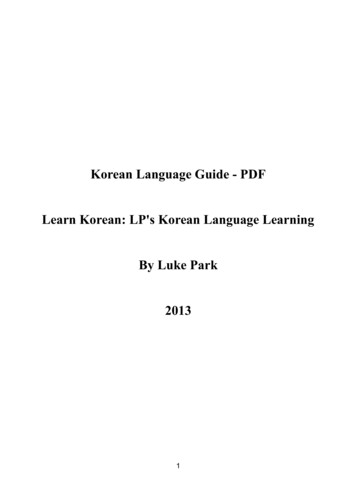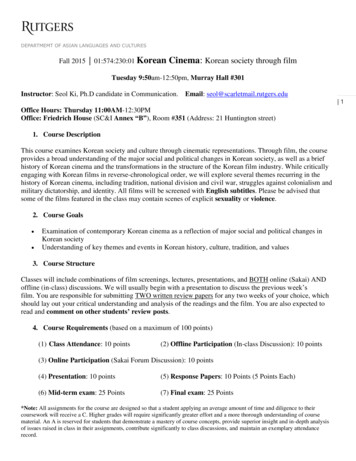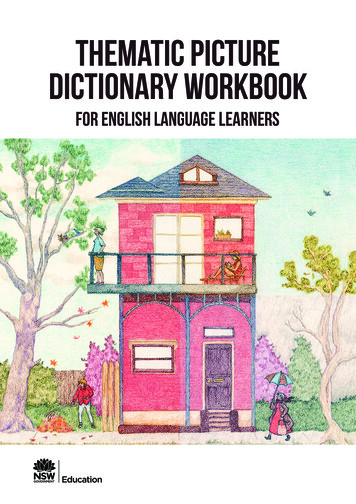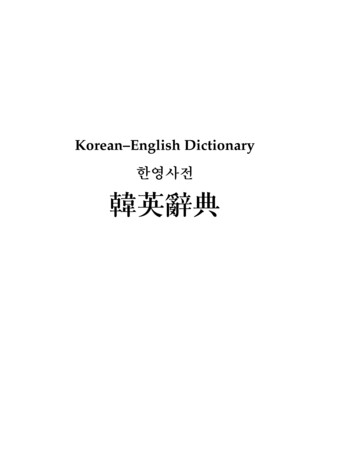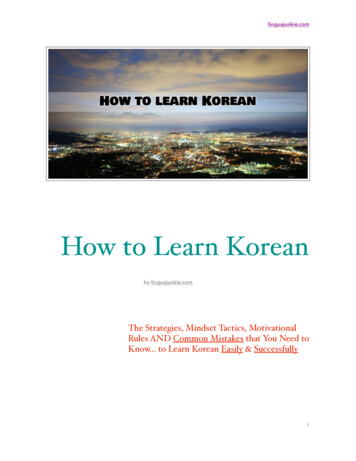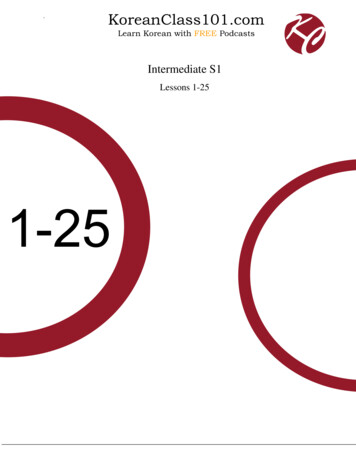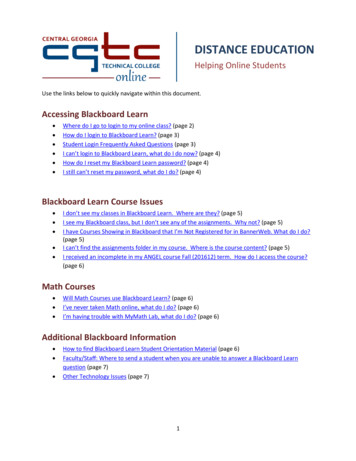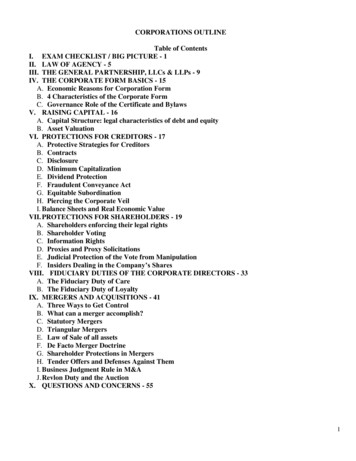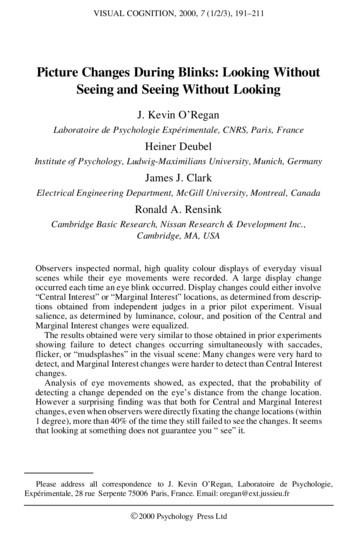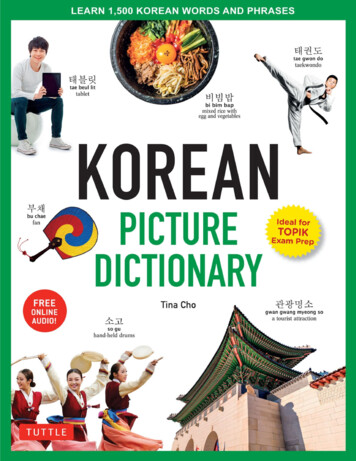
Transcription
KOREANPICTURE DICTIONARYLEARN 1,500 KEY KOREAN WORDS ANDPHRASESTina ChoKorean text by Jaekeun Cho
ContentsA Basic Introduction to Korean Language123456Nice to Meet You!만나서 매우 반갑습니다!My Family나의 가족My House나의 집The Human Body인체Counting and Numbers카운팅과 숫자Daily Activities일상생활
78Colors, Shapes and Sizes색상, 모양, 크기Opposites반대들9 Cash and Money현금과 돈10 Going Shopping쇼핑하기11 Life in the City도시의 생활12 Getting Around
이동 수단13 Asking and Giving Directions방향 묻고 말하기14 Talking About the Weather날씨 말하기15 Telling Time시간 알림16 Years and Dates년도와 날짜17 Seasons of the Year사계절18 Celebrating the Holidays공휴일 행사19 I love to Learn배우기를 좋아해요20 At School학교에서
21 I Am Learning Korean한글 배우기22 Counting Words수분류어23 Computers and the Internet컴퓨터와 인터넷24 I Love My Smartphone!스마트폰이 좋아요!25 At Work직업26 Music and Dance음악과 무용27 Seeing a Doctor의사 방문28 Protecting Our Environment환경 보호
29 The Animal Kingdom동물의 세계30 Let’s Keep Fit!건강하게 지냅시다!31 Do You Like to Travel?여행을 좋아하세요?32 Countries of the World세계 각국33 Foreign Languages외국어34 Do You Like Korean Food?한국음식을 좋아하세요?35 Popular Western Foods대중 서양 음식36 Drinks음료수37 Fresh Fruits, Nuts and Grains신선한 과일, 견과, 곡물38 At the Market시장에서English-Korean IndexPhoto Credits
A Basic Introduction to KoreanLanguageThis illustrated dictionary presents 1,500 frequently-used Koreanwords and phrases, including those that students need to know to passthe TOPIK, Test of Proficiency in Korean exam for non-nativespeakers. The dictionary is organized into 38 themes, each of whichpresents 30-40 words. Each section also has three to five sentencesdemonstrating the usage of the words. The words and sentences in thedictionary all appear in the following order: Hangeul characters,followed by the pronunciation in standard romanization form,followed by the English meaning.History of the Korean LanguageResearchers and linguists debate the origin of the Korean language.Some link it with the Altaic language family, which includesMongolian, Turkic, and Tungusic language groups. The people withinthese groups lived in the Altai Mountain Region, which includednortheastern Siberia to the Persian Gulf and from the Baltic Sea toChina. These languages have similar components. The syllables arecomposed of a consonant a vowel. They have vowel harmony.There are constraints on which vowels can be put together. And thereare few consonant clusters.Korean is one of the oldest spoken languages. History shows thattwo languages were spoken in Manchuria and on the Koreanpeninsula, the Northern or Puyo group and the Southern or Han group.During the 7th century, during the time of the Three KingdomsPeriod, the Silla dialect became the dominant language. Then in the10th century, the Koryo Dynasty moved the capital to Kaesong, in
which the Kaesong dialect became the dominant language. At the endof the 14th century, the Chosun Dynasty moved the capital to Seoul;however, the language remained the same.Before the 15th century, the Korean language was written usingclassical Chinese hanja characters that only elite scholarly peopleknew. This form of writing was too difficult to teach to all the people.Also, hanja reflected the meaning of words but not the sounds of theKorean language. The people couldn’t express themselves properly intheir language and had to simplify by using the Chinese hanja.Therefore, in 1443, King Sejong, with the help of scholars and hisolder children, created Hangeul, the phonetic Korean writing system.Hangeul became an easy writing system for the common people ofKorea and has led to their high literacy rate. Hangeul tied the socioeconomic classes of Korea together. Now, everyone could read andwrite, not just the literati. Hanja or Chinese characters are still used onformal documents and birth certificates as most Korean names andtheir meanings are derived from Chinese characters. Around 1800hanja are still taught in Korean public schools.Hangeul, noted as a scientific alphabet, has unified the countryand has been their source of pride. During Japanese colonialoccupation (1910–1945), Koreans were denied their language. Theywere forced to learn Japanese. But the people showed unity andresisted Japanese rule through their language. Just like otherlanguages, there are dialects among the provinces, but the only dialectthat is quite different is the dialect spoken on Jeju Island, south of themainland. Today Koreans celebrate their language on October 9,Hangeul Day, and they are the only country in the world to do so.The Korean AlphabetThe Korean alphabet was written specifically for the Koreanlanguage. Therefore, all Korean letters only make one or at the mosttwo sounds; whereas, an English vowel can make several sounds.Hangeul is hard to use with foreign words. For example, when a word
ends with a hard consonant, Koreans add an additional “eu” sound tothe ending. Also, there is no f, v, or z in Hangeul. Fork is pronounced“po-keu.” Page is pronounced “pay-jee,” and trump is “trum-peu.”Hangeul is written in syllables rather than one letter behind theother. The shapes of the letters correspond to the shape of the mouth,tongue, and throat when pronouncing the sound. There are 10 vowelsand 14 consonants. However, there are also 5 double consonants and11 vowel combinations or dipthongs, which you’ll see in the tablebelow.The Romanization of KoreanWhen writing Korean sounds using English letters, one mustremember that the romanization will always make the same sound,unlike English vowels where an “a” can have many sounds like in bat,father, and date. You might see a Korean word written withromanization in various ways (for example: the city of Pyeongtaek,Pyongtaek, and Pyungtaek). Which way is correct? The Koreangovernment has devised an official romanization system, but youmight still see variations on signs and other places because of dialectsand long ago there were different systems of spelling usingromanization. Today there are two systems of spellings remaining: theMcCune-Reischauer system and the government sponsored system.The first was devised in the early 1930s by children of missionarieswho grew up in Asia, George M. McCune and Edwin O. Reischauer.It was used until 2000, when the government created its own RevisedRomanization of Korean by the Ministry of Culture and Tourism. Thegovernment system is the official system and more commonly used.Below are examples of Korean romanization.The Korean Alphabet and Roman Letters
Vowelseo, eu, ae and oe are single vowels in romanized Korean as shownbelow. Therefore careful attention should be given to these vowels:take care that you are not splitting them into two. Also, carefulattention should be given to “u/우”—do not read it as an English“you.” Some common vowels which might confuse you could be:아 ah, father(shorter than these as)a어 bird, serveeo오 ball, poreo(shorter than this a or o)
우 book, school(shorter that these oos)u으 broken, goldeneu이 bee, sheep(shorter than these ees)i애 apple, badae에 bed, egge외 wear, welcomeoeConsonantsYou won’t have much trouble pronouncing romanized Koreanconsonants except for some tensed ones which require a relativelystrong muscular effort in the vocal organs without the expulsion of air.Here are some examples:ㄲ ski, sky(k after s)ㄸ steak, sting(t after s)kktt
ㅃ speak, spy(p after s)ㅆ sea, sir(s before a vowel)ppssㅉ bridge, midget (similar to a tutting sound in an exhaling way)jjWhen reading in Hangeul, remember to read from top to bottom, thenleft to right. A consonant-vowel-consonant (CVC) syllable is writtenlike this in Korean:CVCIf I was writing the word bat the Korean way, it would look like bathis:tThe word wonderful would be grouped like this:Here’s how the word potato looks in Korean:wonderful감자kam jaCan you figure out this word? 학교This is the word hak/kyo, meaning school.Let’s try the sentence, “I want a dog.” How would you read this?
Let’s try the sentence, “I want a dog.” How would you read this?나는 개가 필요해.Naneun gaega pilyohae.This literally translates to “I dog want.” Korean doesn’t have thearticles “a” or “an.”GrammarThe goal of this book is to teach vocabulary and phrases in Korean,allowing students to learn Korean grammar through induction. That is,students see how the grammar is used in context for communication,and draw conclusions as to grammar rules from these observations.Having said that, here are a few quick notes on Korean grammar toget you oriented.In reading sentences, remember the verb is always last.Subject, object, verbEXAMPLE:In English we would say Anna eats cake.But in Korean, we would say Anna cake eats.The other words in a sentence usually have topic markers. Thatmeans the words are marked as to whether they are the subject orobject of the sentence.EXAMPLE:In English: Anna eats cake. (subject, verb, object)In Korean: Anna[ga] cake[ul] eats.Korean is not a tonal language like Chinese. But similarly, withEnglish, when you ask a question, you have a rising tone toward theend. Declarative sentences end with a falling tone.How to Use This Picture DictionaryFirst, when learning Korean, it is best to play to your strengths. Focus
First, when learning Korean, it is best to play to your strengths. Focuson what you do best (for example, speaking or reading), and comeback and learn the rest later.Second, as the vocabulary in this book is arranged by theme, it isbest to approach this dictionary topically, rather than systematically.Find the topics that are useful or of interest to you, and learn thosewords first. Third, practice and use the words in context with theconversations and phrases provided.Fourth, listen to the audio recordings several times and read or saythe Korean words aloud as you look at the pictures. You can also useyour finger to trace out the corresponding Korean characters as you doso. If you have time, practice writing the characters in a notebook oron blank sheets of paper. This will help reinforce your memory of thevocabulary and phrases.Finally, this picture dictionary should be just a beginning and notan end. If you find a topic that interest you, use the information in thepicture dictionary as a jumping off point to learn more about that topicin Korean.There are indexes at the end of the book which will help you findthe meanings of words you have learned, but which you may haveforgotten. The following information is included for each entry—theEnglish word, the Korean word in Hangeul, the romanization, thelesson number and the order in which the word appeared in thatlesson, followed by the page number where the word appears. Forexample:The free online audio contains recording of native Koreanspeakers reading all the vocabulary and sentences, so students canquickly acquire the correct pronunciation. A link to download therecordings can be found on page 96.
7색상, 모양, 크기Saeksang, moyang, keugiColors, Shapes and Sizes
Additional Vocabulary
색상saek sangcolor모양mo yangshape크기keu gisize더큰deo keunlarger더 작은deo jakeunsmaller
17사계절Sa gyae jeolSeasons of the Year
Additional Vocabulary계절gyae jeolseason
season사계절sa gyae jeolfour seasons
25직업Jik eopAt Work
Additional Vocabulary회사hui sacompany경찰관gyeong chal gwanpolice officer
police officer수표su pyoto check출근chul geungoing to work부사장bu sa jangvice president작업jak eopwork직원jik wonemployee기술자gi sul jatechnician사장sa jangCEO아르바이트a reu ba i teu
part time고용go yongemployment가게 주인ga gae ju inshop owner무슨 일을 하세요? 저는 병원에서 일해요.Museun ileul hasaeyo? Jeoneun byeongwonaeseo ilhaeyo.What sort of work do you do? I work in a hospital.저는 의사가 되기위해 훈련하고있습니다.Jeoneun uisaga dwaegiwihae hunryeonhago itsseumnida.I’m training to be a doctor.
33외국어Wei kuk eoForeign Languages
모국어가 뭐에요?Mokukeoga mueoeyo?What is your mother tongue?몇개 언어를 말해요?Myeotgae eoneoreul malhaeyo?How many languages do you speak?
How many languages do you speak?
English-Korean Index10 won 십원 sip won [9-4] 24100 won 백원 baek won [9-6] 24100th Day 백일 baek il [18-29] 431,000 won 천원 cheon won [9-8] 2410,000 won 만원 man won [9-10] 2450 won 오십원 o sip won [9-5] 24500 won 오백원 o baek won [9-7] 245,000 won 오천원 o cheon won [9-9] 2450,000 won 오만원 o man won [9-11] 246 o’clock 정각 6시 jeong gak yeoseot si [15-4] 36Aa brief moment 잠시 jam si [15-30] 37a circle 원 won [7-19] 21a diamond 마름모 ma reum mo [7-28] 21a gentle breeze 산들바람 sandeul baram [17-6] 40a heart 하트 ha teu [7-23] 21a hexagon 육각형 yuk gak hyeong [7-27] 21a little later 잠시후 jam si hu [15-25] 37a moment ago 조금전 jo geum jeon [15-31] 37a pentagon 오각형 o gak hyeong [7-21] 21a question; problem 질문; 문제 jil mun; mun jae [19-27] 45a rainbow 무지개 mu ji gae [7-17] 20a rectangle 직사각형 jik sa gak hyeong [7-18] 21a square 정사각형 jeong sa gak hyeong [7-22] 21a star 별 byeol [7-25] 21
a triangle 삼각형 sam gak hyeong [7-26] 21above 위 wi [13-4] 32accent 억양 eok yang [21-10] 49accident 사고 sa go [27-34] 61actor 배우 bae u [26-16] 59adhesive tape 반창고 ban chang go [27-52] 61agency 대행사 dae haeng sa [31-23] 69air 공기 gong gi [28-11] 62airport 공항 gong hang [11-2] 28; [31-35] 69alarm clock 자명종 ja myeong jong [15-12] 37album 앨범 ael beom [26-25] 59all the time 항상 hang sang [15-23] 37alphabet 알파벳 al pa baet [20-21] 47an octagon 팔각형 pal gak hyeong [7-20] 21an oval 타원형 ta won hyeong [7-24] 21abdomen 복부 bok bu [4-27] 15Africa 아프리카 A peu ri ka [32-17] 71air conditioner 에어컨 ae eo keon [3-15] 12air pollution 공기오염 gonggioyeom [14-36] 35airplane 비행기 bi haeng gi [12-4] 30allergy 알레르기 allaereugi [37-49] 81already 이미 imi [13-59] 33almonds 아몬드 amondeu [37-24] 81altogether 모두 modu [10-32] 27ambulance 구급차 gugeubcha [27-21] 61America 미국 Mi kuk [32-24] 71Android phones 안드로이드폰 andeuroideu pon [24-7] 54ankle 발목 bal mok [4-29] 15anniversary 기념일 gi nyeom il [18-28] 43answer 대답하다 dae dap ha da [6-22] 18Antartica 남극 Nam geuk [32-20] 71antiseptic 소독제 so dok jae [27-36] 61anxious; worried 불안한; 걱정 bul-anhan; geogjeong [27-45] 61
apartment 아파트 a pa teu [3-52] 12; apartment; house 아파트; 집 a pa teu; jip [1125] 29apartment building 아파트 단지 a pa teu dan ji [11-13] 28app 앱 aep [23-40] 53apple (fruit) 사과 sagwa [37-1] 80Apple 애플 ae peul [24-22] 55Apple phones 애플폰 aepeul pon [24-8] 54apple pie 애플파이 ae peul pa i [35-11] 76application (computer program) aeisyeon (keompyuteo peurogeuraem) [23-27] 53appointment 예약 yaeyak [27-20] 61April 사월 sa wal [16-19] 39Arabic 아랍어 A rab eo [33-9] 64area code 지역번호 jiyeok beonho [24-33] 54arm 팔 pal [4-19] 15arrival 도착 do chak [31-45] 69arrive 도착 do chak [8-21] 23art 미술 mi sul [19-42] 45art museum 미술관 mi sul gwan [11-14] 29artist 예술가 yae sul ga [25-7] 56asking directions 방향묻기 banghyang mutgi [13-16] 32Asia 아시아 A si a [32-18] 71asparagus 아스파라거스 aseuparageoseu [38-47] 83attend a birthday party 생일파티참석 saengil pati chamseok [18-24] 43attic; loft 다락방 da rak bang [3-54] 12audience 청중 cheongjung [26-14] 59auditorium 강당 gang dang [20-18] 47August 팔월 pal wal [16-23] 39aunt (father’s sister) 고모 go mo [2-25] 10aunt (mother’s sister) 이모 ee mo [2-15] 11Australia 오스트레일리아 O seu teu rae il li a [32-19] 71Australia 호주 Ho ju [32-26] 71autumn; fall 가을 ga eul [17-3] 40
Autumn Festival 추석 chu seok [18-15] 43Bbaby 아기 a gi [2-31] 10bacon; smoked ham 베이컨; 훈제햄 bae i keon; hunjae haem [35-20] 77bad 나쁜 na ppeun [8-7] 22bad weather 나쁜 날씨 nabbeun nalssi [14-34] 35badminton 배드민턴 bae deu min teon [30-5] 66baguette 바게트 ba gae teu [35-6] 76balcony 발코니 bal ko ni [3-2] 12ball 공 gong [30-27] 67ball pen 볼펜 bol paen [19-16] 45banana 바나나 banana [37-7] 80bandage 붕대 bungdae [27-51] 61bank 은행 eun haeng [11-7] 28bankbook 통장 tong jang [9-23] 25barbecue 바베큐 ba bae kyu [35-31] 77barley 보리 bori [37-35] 81baseball 야구 ya gu [30-7] 66basement; cellar 지하실 ji ha sil [3-55] 12basil 바질 ba jil [38-49] 83bathroom 화장실 hwa jang sil [3-37] 13bathtub 욕조 yok jo [3-42] 13beans 콩 kong [37-45] 81bear 곰 gom [29-7] 64beach 바닷가 ba dat ga [31-32] 69bean sprouts 콩나물 kong na mul [38-22] 82beard 수염 su yeom [4-46] 15beautiful 아름다운 a reum da un [8-9] 22bed 침대 chim dae [3-20] 12bedroom 침실 chim sil [3-21] 12
bee 벌 beol [29-29] 65beef 소고기 so go gi [38-2] 82beef soup with rice 설렁탕 seol reol tang [34-7] 74beer 맥주 maek ju [36-26] 79before 전에 jeon ae [15-28] 37begin 시작 si jak [8-24] 23behind 뒤 dwi [13-15] 32bell 종 jong [26-6] 58bell pepper 피망 pi mang [38-24] 83below 아래 arae [13-5] 32belt 벨트 baelteu [10-19] 27between; among 사이에 saie [15-29] 37beverage 음료 eum ryo [36-1] 78bicycle 자전거 ja jeon geo [30-11] 66big 큰 keun [8-12] 23bill; invoice 청구서; 송장 cheongguseo; songjang [10-40] 27bird 새 sae [29-22] 65birthday 생일 saeng il [18-23] 43black 검정색 geom jeong saek [7-4] 20black Chinese noodles 자장면 ja jang myeon [34-20] 75Black Day 블랙데이 beullaek daei [18-31] 43Black Friday 블랙프라이데이 beullaekpeuraidaei [10-21] 27blackboard 칠판 chil pan [20-2] 46blog 블로그 beul lo geu [23-35] 53blood 피 pi [4-42] 15blood pressure 혈압 hyeol ab [27-9] 60blood test 피검사 pi geomsa [27-7] 60blouse 블라우스 beullauseu [10-7] 26blue 파란색 pa ran sae [7-6] 20bone 뼈 ppyeo [4-44] 15books 책 chaek [19-7] 44bookshelf 책꽂이 chaek ggoji [3-35] 13boots 부츠 bu cheu [14-3] 34
bottle 병 byeong [36-34] 79boutique 부티크 butikeu [10-24] 27bowl 그릇 geu reut [34-9] 74boy’s older brother 형 hyung [2-17] 11boy’s older sister 누나 nu na [2-16] 11brain 뇌 nui [4-30] 15breath 호흡 ho heup [4-40] 15bridge 다리 da ri [11-26] 29broccoli 브로콜리 beu ro kol li [38-34] 83brown 갈색 gal saek [7-9] 20browser 브라우저 beu ra u jeo [23-36] 53Brunei 브루나이 Beu ru na i [32-9] 70buckwheat 메밀 maemil [37-37] 81Buddha’s Birthday 부처님오신날 bucheonim osinnal [18-5] 42bus 버스 beo seu [12-12] 31bus route 버스노선 beoseu noseon [12-32] 31bus stop 버스정류장 beo seu jeong ryu jang [12-13] 31butter; cream 버터; 크림 beoteo; keurim [35-34] 77butterfly 나비 na bi [29-30] 65Ccabinet 캐비닛 kae bi nit [3-25] 13cafe 카페 ka pae [31-30] 69cake 케이크 kae i keu [35-23] 77calculator 계산기 gyaesangi [5-16] 17; [19-33] 45; [20-11] 46calendar 달력 dal ryeok [16-1] 38calligraphy 서법 seo beop [21-3] 48Cambodia 캄보디아 Kam bo di a [32-7] 70camera 카메라 ka mae ra [31-13] 68cantaloupe 칸탈루프 kantallupeu [37-17] 80car 자동차 ja dong cha [12-1] 30
carpet 카펫 ka paet [3-11] 12carrot 당근 dang geun [38-35] 83cash 현금 hyeon geum [9-31] 25cashew nuts 캐슈넛 kaesyuneot [37-29] 81cashier 계산원 gyaesanwon [10-26] 27cat 고양이 go yang i [29-26] 65catch a bus 버스를잡다 beoseureul japda [12-21] 31catch a train 기차를잡다 gichareul japda [12-22] 31CD/DVD 씨디/디비디 ssidi/dibidi [23-12] 52ceiling 천장 cheon jeong [3-4] 12ceiling light 천정등 cheon jeong deung [3-16] 12cello 첼로 chello [26-17] 59celery 셀러리 sael leo ri [38-27] 83century (100 years) 세기 sae gi [16-38] 39cereal 시리얼 si ri eol [35-25] 77cereals; grains 곡물 gokmul [37-40] 81certainly 분명히 bunmyeonghi [10-33] 27CEO 사장 sa jang [25-28] 57chair 의자 ui ja [3-7] 12Champagne 샴페인 Syam pae in [36-22] 79changes 변화 byeon hwa [28-30] 63chat room 대화방 dae hwa bang [23-32] 53cheap 싼 ssan [9-21] 25check 수표 su pyo [9-12] 25cheek 볼 bol [4-4] 14cheese 치즈 chi jeu [35-24] 77chef 요리사 yo ri sa [25-11] 57chemistry 화학 hwa hak [19-41] 45Cherry Blossom Festival 벚꽃축제 beotggot chukjae [18-8] 42chest 가슴 ga seum [4-26] 15chestnuts 밤 bam [37-26] 81chicken 닭 dak [29-10] 64chicken 닭고기 dak go gi [38-9] 82
children 아이들 a i deul [2-4] 10Children’s Day 어린이날 eorininal [18-7] 42chili peppers 고추 go chu [38-37] 83chin 턱 teok [4-13] 14China 중국 Jung kuk [32-23] 71Chinese cabbage 배추 bae chu [38-41] 83Chinese chives 산파 san pa [38-23] 83chocolates 초코렛 cho ko laet [18-13] 43chopsticks 젓가락 jeot ga rak [34-8] 74Christmas Day 크리스마스 keu ri seu ma seu [18-21] 43chrysanthemum greens 쑥갓 ssukgat [38-19] 82church 교회 gyo hwei [11-32] 29city 도시 do si [11-11] 28city hall 시청 si cheong [11-23] 29civil servant 공무원 gong mu won [25-13] 57classical 클래식 keul lae sik [26-29] 59classmates 급우 geup u [20-13] 46classroom 교실 gyo sil [19-44] 45; [20-4] 46clean 깨끗한 ggae ggeut han [28-17] 63; 청정 cheong jeong [28-27] 63clear (sky) 맑은(하늘) malgeun (haneul) [14-4] 34clear day 맑은날 malgeun nal [14-5] 34clock 시계 si gyae [15-6] 36closed 닫힌 dachin [8-13] 23clothes 옷 ot [10-6] 26clothing size 옷치수 ot chisu [7-29] 21cloud 구름 gu reum [14-23] 35cloudy 흐린 heu rin [14-6] 34consonant 자음 jaeum [21-5] 49coat or jacket 코트/자 koteu/jakaet [14-17] 35coconut 코코넛 kokoneot [37-6] 80coffee 커피 keo pi [35-19] 77; [36-6] 78coffee table 탁자 tak ja [3-10] 12cocktails 칵테일 kak tae il [36-18] 79
cola 콜라 kol la [36-10] 78cold 추운 chuun [14-21] 35cold water 찬물 chan mul [36-30] 79cold weather 추운날씨 chuun nalssi [14-22] 35color 색상 saek sang [7-38] 21;색 saek [7-1] 20coin; money 동전;돈 dongjeon; don [9-18] 25coins 동전 dong jeon [9-3] 24come 오다 o da [8-18] 23company 회사 hui sa [25-20] 57comparing prices 가격비교 gagyeokbigyo [10-28] 27compass 나침반 na chim ban [12-31] 31compatible 호환가능한 hohwan ganeunghan [23-25] 53competition 시합 si hab [30-13] 67composition 문장 mun jang [19-37] 45computers 컴퓨터 keom pyu teo [23-1] 52computer lab 컴퓨터실 keom pyu teo sil [20-19] 47concert 연주회 yeon ju hwei [26-13] 59conference center 회의장 hwei ui jang [11-8] 28conscientious; serious 성실한; 진지한 seong sil han; jin ji han [19-47] 45construction worker 공사장인부 gong sa jang in bu [25-18] 57cook; chef 요리사 yo ri sa [34-3] 74coriander leaves; cilantro 코리앤더; 실란트로 koriaendeo; sillanteuro [38-6] 82corn 옥수수 oksusu [37-46] 81; [38-20] 82cosmetics 화장품 hwajangpum [10-17] 27country code 나라 번호 nara beonho [24-32] 54Countries in Southeast Asia 동남아시아 Dongnam a si a [32-1] 70course 과목 gwamok [21-22] 49cousin 조카 jo ka [2-28] 10cousins 사촌 sa chon [2-29] 10cow 소 so [29-16] 65crackers 크래커 keuraekeo [37-42] 81credit card 신용카드 sin yong ka deu [9-14] 25; [10-30] 27crops 농작물 nong jak mul [17-17] 41
cucumber 오이 o i [38-33] 83culture 문화 munhwa [21-17] 49currency 통화 tong hwa [31-20] 69currency exchange 외화환전 weihwa hwanjeon [9-16] 25curtain 커튼 keo teun [3-17] 12Ddad 아빠 a ppa [2-37] 10Dano Festival 단오축제 dano chukjae [18-32] 43dance (performance art) 무용 mu yong [26-21] 59dark color 어두운색 eoduun saek [7-15] 20dark soy sauce 진간장 jin kanjang [38-71] 84daughter 딸 ddal [2-5] 10day 일 il [16-3] 38day of a month 날짜 nal jja [16-36] 39decade (10 years) 10년 sip nyeon [16-37] 39December 십이월 sip i wal [16-27] 39decision 결정 gyeoljeong [10-36] 27debt 부채 bu chae [9-25] 25deer 사슴 sa seum [29-8] 64dentistry 치과 chigwa [27-22] 61depart 출발 chul bal [8-21] 23department store 백화점 baekhwajeom [10-23] 27delivery van 배달용밴 baedalyong baen [12-7] 30dentist 치과의사 chi gwa ui sa [25-14] 57deposit 예금 yea geum [9-26] 25dermatology 피부과 pibugwa [27-29] 61desk 책상 chaek sang [3-36] 13diary 일기 il gi [16-44] 39; il gi [31-22] 69dictionary 사전 sa jeon [19-11] 44diet drinks 다이어트음료수 da i eo teu eum ryo su [36-15] 78
difficult 어려운 eoryeoun [8-16] 23; [21-28] 49digestion 소화 so hwa [4-37] 15digits 자릿수 jaritsu [5-29] 17dill 딜 dil [38-13] 82dining table 저녁 식탁 jeonyeok siktak [6-31] 18dish of steamed rice, vegetables, egg and mea 비빔밥 bi bim bap [34-16] 75distance 거리 geori [13-37] 33direction 방향 banghyang [13-36] 33discount 할인 hal in [9-20] 25do not have 없다 eop da [8-17] 23doctor 의사 ui sa [27-4] 60doctor’s consultation room 상담실 sangdamshil [27-18] 60dog 개 gae [29-25] 65donuts 도너츠 do neo cheu [35-5] 76door 문 mun [3-46] 13down 아래 a rae [8-1] 22dragon 용 yong [29-23] 65drawer 서랍 seo rap [3-32] 13dried fruits 건과 geongwa [37-44] 81drive a car 차를운전하다 chareul unjeonhada [12-24] 31driver 운전사 un jeon sa [12-3] 30drum 북 buk [26-5] 58dry 마른 ma reun [8-8] 22duck 오리 o ri [29-9] 64duck 오리고기 o ri go gi [38-8] 82dumplings 만두 man du [34-18] 75Eear 귀 gwi [4-2] 14ear, nose and throat 이빈후과 i bin hu gwa [27-25] 61early 일찍 il jjik [15-24] 37
early morning 이른 아침 il reun a chim [15-18] 37earth; ground 지구; 땅 ji gu; ddang [28-31] 63east 동 dong [13-10] 32East Timor 동티모르 Dong ti mo reu [32-12] 70Easter 부활절 bu hwal jeol [18-18] 43easy 쉬운 swiun [8-16] 23; [21-27] 49eat till full 배부른 bae bu reun [8-20] 23eggplant 가지 ga ji [38-25] 83eggs 계란 gyae ran [38-16] 82eight 여덟 yeodeol [5-8] 16eight pieces of clothing 옷여덟벌 ot yeodeolbeol [22-5] 50elbow 팔꿈치 pal ggum chi [4-20] 15electric car 전동차 jeon dong cha [28-6] 62electric socket; power point 전기 소켓 jeongi sokaet [3-50] 12elementary school 초등학 cho deung hak gyo [20-27] 47elephant 코끼리 ko kki ri [29-17] 65elevator 승강기 seung gang gi [3-45] 13email 이메일 i mae il [23-15] 52embassy 대사관 dae sa gwan [31-28] 69emergency 비상 bi sang [27-39] 61emergency room 응급실 ueng geup shil [27-2] 60employee 직원 jik won [25-26] 57employment 고용 go yong [25-30] 57end 끝 ggeut [8-24] 23engineer 기술자 gi sul ja [25-4] 56English 영어 yeong eo [19-38] 45; [33-1] 64enter 들어가다 deul-eogada [8-6] 22energy drinks 에너지음료 ae neo ji eum ryo [36-16] 78environment 환경 hwan gyeong [28-28] 63equals 같은 gateun [5-21] 17eraser 지우개 ji u gae [19-15] 45essay 에세이 aesaei [21-16] 49Europe 유럽 Yu reop [32-16] 71
eye 눈 nun [4-8] 14eyebrow 눈썹 nun sseop [4-7] 14even numbers 짝수 jjaksu [5-25] 17exam 시험 si heom [19-1] 44exercise book 연습장 yeonseupjang [21-24] 49exit 출구 chul gu [8-6] 22expensive 비싼 bi ssan [9-22] 25expressway 고속도로 go sok do ro [11-18] 29Fface 얼굴 eol gul [4-5] 14Facebook 페이스북 pae i seu bok [24-18] 55fake 가짜 ga jja [8-27] 23family 가족 ga jok [2-30] 10fan 부채 buchae [17-14] 41far 먼 meon [8-25] 23; [13-43] 33farmer 농부 nong bu [25-19] 57fast 빠른 ppa reun [8-28] 23fat 뚱뚱한 ddungddunghan [8-14] 23father 아버지 abuh ji [2-12] 11faucet 수도꼭지 su do ggok ji [3-39] 13February 이월 i wal [16-17] 39female 여자 yeo ja [2-3] 10fermented anchovy sauce 멸치액젓 myulchiaekjeot [38-58 84fermented shrimp 새우젓 saeujeot [38-70] 84festival; holiday 축제, 휴일 chukjae, hyuil [18-1] 42fever 열 yeol [27-12] 60fifteen minutes past six 6시 15분 yeoseotsi sipobun [15-8] 36fifteen minutes to seven 7시15분전 ilgopsi simobunjeon [15-10] 36file 파일 pa il [23-22] 53fingers 손가락 son ga rak [4-15] 14
fingernails 손톱 son top [4-43] 15finishing line 결승선 gyeol seung seon [30-14] 67fire engine 소방차 so bang cha [12-16] 31fireworks 불꽃놀이 bul ggot nol i [18-3] 42first aid kit 구급상자 gugeub sangja [27-50] 61first birthday 돌 dol [18-6] 42First we’ll prepare the ingredients, and then we’ll start to cook. �. Meonjeo jaelyoleul junbihago yolileul sijaghabnida. [38-76]84fish 물고기 mul go gi [29-31] 65; [38-15] 82five 다섯 daseot [5-5] 16five minutes past six 6시5분 yeoseotsi o bun [15-5] 36five minutes to seven 7시5분전 ilgopsi obunjeon [15-11] 36five tickets 표다섯장 pyo da seot jang [22-4] 50flash cards 플래시카드 peullaesi kadeu [21-7] 49floor 바닥 ba da [3-14] 12flour 밀가루 milgaru [37-47] 81flower 꽃 ggot [28-2] 62flower pot 화분 hwa bun [28-25] 63fog 안개 an gae [14-24] 35foot 발 bal [4-23] 15; 피트 piteu [13-41] 33forehead 이마 i ma [4-17] 15foreign language 외국어 wui kuk eo [19-43] 45foreigner 외국인 wei kuk in [31-10] 68forest 숲 sup [28-13] 63fork 포크 po keu [34-13] 74four 넷 naet [5-4] 16four seasons 사계절 sa gyae jeol [17-19] 41four-story building 사층건물 sacheung geonmul [22-11] 51fraction 분수 bunsu [5-24] 17French 프랑스어 Peu rang seu eo [33-2] 64french fries 감자튀김 gamja twigim [35-28] 77frequently 자주 ja ju [15-33] 37
fresh 신선한 sin seon han [38-53] 83freshman 대학1학년 daehak ilhaknyeon [20-34] 47Friday 금요일 geum yo il [16-14] 38friend 친구 chin gu [1-13] 8frog 개구리 gae gu ri [29-12] 64from 부터 buteo [27-43] 61fruit juice 과일쥬스 gwail juseu [35-18] 77; [36-3] 78future 미래 mi rae [8-23] 23Ggarage 차고 cha go [3-56] 12garbage truck 쓰레기차 sseu rae gi cha [12-6] 30garden 정원 jeong won [28-1] 62garlic 마늘 ma neul [38-29] 83gas station; petrol statio 주유소 ju yu so [11-6] 28gathering; meeting 모임 mo im [1-19] 9general medicine 내과 naegwa [27-23] 61general surgery 외과 wuigwa [27-24] 61generally 일반적으로 ilbanjeokeuro [10-34] 27German 독일어 Dok il eo [33-4] 64gift 선물 seon mul [18-20] 43ginger 생강 saeng gang [38-30] 83ginseng 인삼 in sam [34-30] 75ginseng chicken soup 삼계탕 samgyetang [34-19] 75giraffe 기린 gilin [29-3] 64girl’s older brother 오빠 o ppa [2-17] 11girl’s older sister 언니 un ni [2-16] 11give 주다 ju da [8-2] 22giving directions 방향알려주기 banghyang alryeojugi [13-21] 32glass; cup 유리; 컵 yuri; keop [36-33] 79glasses; spectacles 안경 angyeong [10-11] 26
globe 지구 ji gu [32-28] 71gloves 장갑 jang gap [14-30] 35Gmarket 지마켓 ji ma kaet [24-16] 55go 가다 ga da [8-18] 23go faster 빨리가다 bbal li ga da [12-27] 31go straight 똑바로가다 ddok ba ro ga da [12-29] 31; 직진 jikjin [13-31] 33go to school 등교하다 deung gyo ha da [6-25] 18go to work/get off work 출근하다/퇴근하다 chulgeunhada/tweigeunhada [6-24] 18goat 염소 yeomso [29-14] 65going to work 출근 chul geun [25-23] 57gold 금색 geum saek [7-13] 20golf 골프 gol peu [30-15] 67good 좋은 jo eun [8-7] 22good weather 좋은날씨 jo eun nalssi [14-33] 35Google 구글 gu geul [24-19] 55grade; class 학년 hak nyeon [19-23] 45grades 성적 seong jeok [20-22] 47grammar 문법 munbeop [21-18] 49grandson 손자 son ja [2-27] 10grapes 포도 podo [37-16] 80grass 풀 pul [28-5] 62gray 회색 hwei saek [7-10] 20Greek 그리스어 Geu ri seu eo [33-10] 65green 녹색 nok saek [7-7] 20green onion pancake 파전 pajeon [34-28] 75groceries 식료품 sik ryo pum [38-44] 83ground/minced beef 간쇠고기 gan swei go gi [38-51] 83ground/minced pork 간돼지고기 gan dwei ji go gi [38-52] 83ground pepper 후추 hu chu [38-63] 84guest; customer 손님 son nim [1-20] 9guitar 기타 gi ta [26-1] 58gym 헬스장 hael seu jang [11-19] 29gynecology 산부인과 san bu in gwa [27-27] 61
Hhail 우박 u bak [14-28] 35hair 머리카락 meo ri ka rak [4-6] 14half past six 6시30 yeoseotsi samsipbun [15-9] 36Halloween 할로윈 hal lo win [18-17] 43ham 햄 haem [35-12] 76hamburger 햄버거 haem beo geo [35-27] 77hand 손 son [4-18] 15Hangame 한게임 han gae im [24-20] 55happy 행복 haengbok [1-10] 8Happy birthday! 생일축하합니다! Saengil chukhahapnida! [18-34] 43harbor 항구 hang gu [28-18] 63harp 하프 hapeu [26-2] 58hat 모자 moja [10-16] 26; [14-29] 35have 있다 it da [8-17] 23hazel nuts 헤이즐넛 haeijeulneot [37-27] 81head 머리 meo ri [4-1] 14health 건강 geon gang [4-47] 15healthy 건강 geon gang [30-28] 67heart 심장 sim jang [4-32] 15Hebrew 히브리어 Hi beu ri eo [33-11] 65hello (on the phone) 여보세요 yeobo seyo [1-36] 9here 여기 yeogi [13-2] 32herb 허브 heo beu [38-50] 83high speed train 고속열차 go sok yeol cha [12-8] 30Hindi 힌두어 Hin du eo [33-13] 65history 역사 yeok sa [19-30] 45home delivery 집배원 jipbaewon [10-27] 27homework 숙제 suk jae [19-28] 45honey 꿀 ggul [38-65] 84honeymoon 신혼여행 sin hon yeo haeng [31-18] 69
horse 말 mal [29-18] 65hospital 병원 byeong won [27-1] 60hot 더운 deo un [14-19] 35hot dog 핫도그 hat do geu [35-1] 76hot pepper paste 고추장 gochujang [38-61] 84hot water 뜨거운물 ddeu geo un mul [36-29] 79hot weath
English word, the Korean word in Hangeul, the romanization, the lesson number and the order in which the word appeared in that lesson, followed by the page number where the word appears. For example: The free online audio contains recording of native Korean speakers
